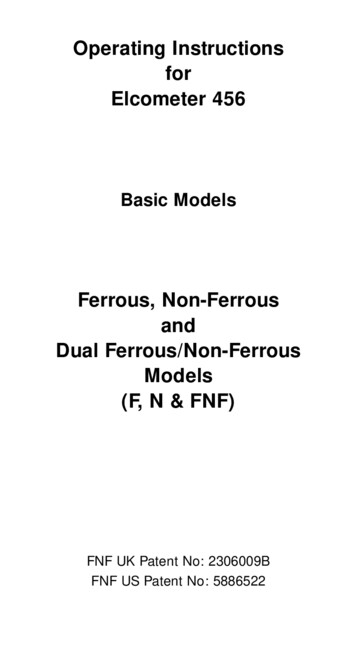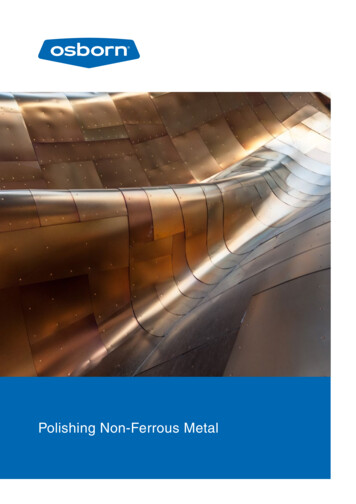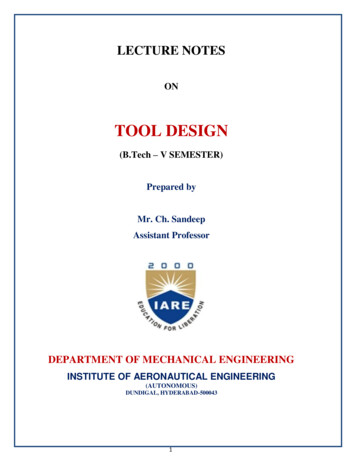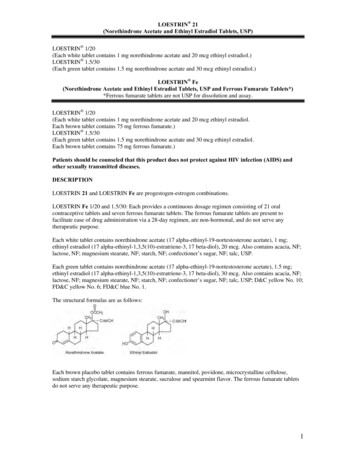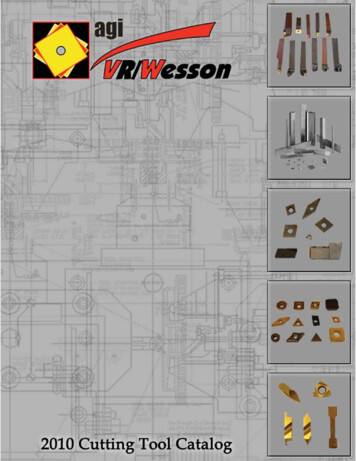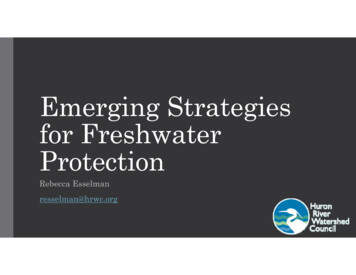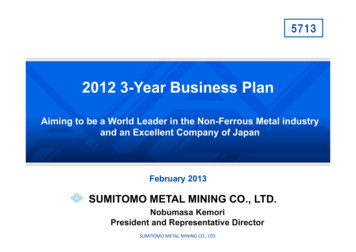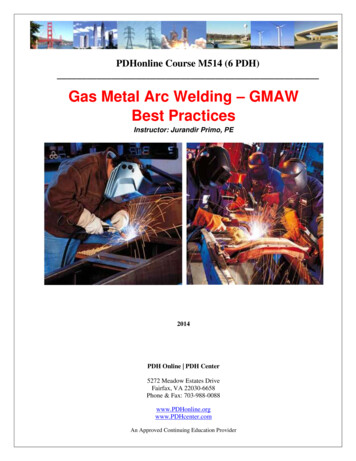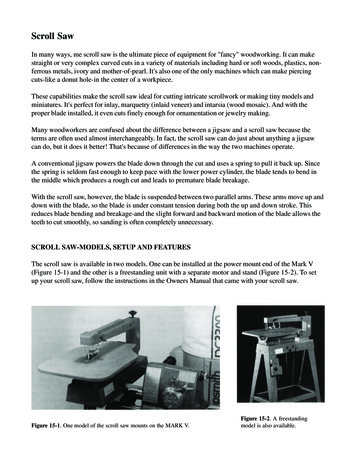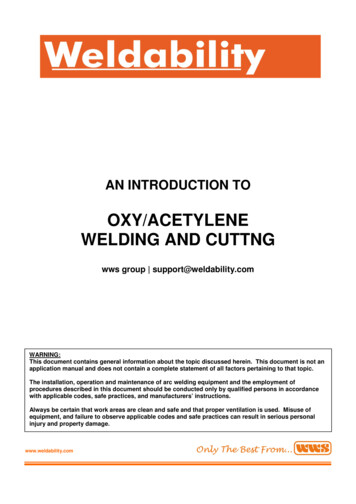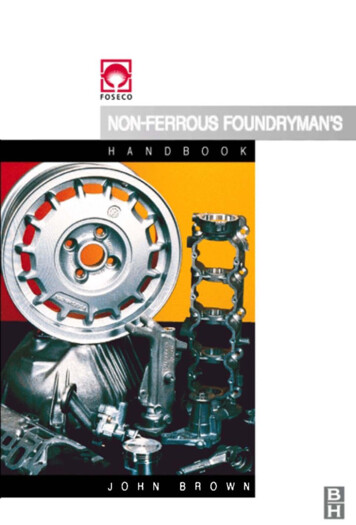
Transcription
Foseco Non-Ferrous Foundryman’s Handbook
This Page Intentionally Left Blank
Foseco Non-FerrousFoundryman’s HandbookEleventh editionRevised and edited byJohn R. BrownOXFORDAUCKLANDBOSTONJOHANNESBURGMELBOURNENEW DELHI
Butterworth-HeinemannLinacre House, Jordan Hill, Oxford OX2 8DP225 Wildwood Avenue, Woburn, MA 01801-2041A division of Reed Educational and Professional Publishing LtdA member of the Reed Elsevier plc groupNinth edition published by Pergamon Press plc 1986Tenth edition 1994Reprinted 1995, 1996, 1998Eleventh edition 1999 Foseco International Ltd 1994, 1999All rights reserved. No part of this publicationmay be reproduced in any material form (includingphotocopying or storing in any medium by electronicmeans and whether or not transiently or incidentallyto some other use of this publication) without thewritten permission of the copyright holder except inaccordance with the provisions of the Copyright,Designs and Patents Act 1988 or under the terms of alicence issued by the Copyright Licensing Agency Ltd,90 Tottenham Court Road, London, England W1P 9HE.Applications for the copyright holder’s written permissionto reproduce any part of this publication should be addressedto the publishersBritish Library Cataloguing in Publication DataBrown, John R.Foseco non-ferrous foundryman’s handbook1. Nonferrous metals – Founding – Handbooks, manuals, etc.I. Title673ISBN 0 7506 4286 6Library of Congress Cataloguing in Publication DataFoseco non-ferrous foundryman’s handbook/revised and edited by JohnR. Brown – 11th ed.p. cm.Prev. eds. published under title: Foseco foundryman’s handbook.ISBN 0 7506 4286 61. Founding Handbooks, manuals, etc. 2. Nonferrous metals –Founding Handbooks, manuals, etc. I. Brown, John R. II. Title:Non-ferrous foundryman’s handbook. III. Title: Foseco c21CIPComposition by Genesis Typesetting, Rochester, KentPrinted and bound in Great Britain
ContentsPrefacexiAcknowledgementsxiiChapter 1 Tables and general data1SI units and their relation to other unitsSI, metric, non-SI and non-metric conversionsConversion table of stress valuesAreas and volumes of circles, spheres, cylinders etc.The physical properties of metalsDensities of casting alloysApproximate bulk densities of common materialsPatternmakers’ contraction allowancesVolume shrinkage of principal casting alloysComparison of sieve sizesCalculation of average grain sizeCalculation of AFS grain fineness numberRecommended standard colours for patternsDust control in foundriesBuoyancy forces on coresCore print supportOpening forces on mouldsDimensional tolerances and consistency achieved in castings125679101113141516171818191921Chapter 2 Aluminium casting alloys23IntroductionCasting alloysCasting processesThe effect of alloying elementsHeat treatment of aluminium alloys2325393942Chapter 3 Melting aluminium alloys46IntroductionRaw materialsMelting furnacesCorundum growthChoice of melting unit4647475455
vi ContentsChapter 4 Fluxes56IntroductionApplication of COVERAL powder fluxesGranular COVERAL fluxes565661Chapter 5 INSURAL refractory for ladles and metal transport63IntroductionLadle liners6365Chapter 6 Treatment of aluminium alloy melts70IntroductionHydrogen gas pick-up in aluminium meltsDegassing aluminium alloysGrain refinement of aluminium alloysModification of aluminium alloysSodium modificationStrontium modificationPermanent modificationMelting procedures for commonly used aluminium alloysSand, gravity die and low pressure diecastingMedium silicon alloys, 4–7% SiEutectic silicon alloys, 12% SiTreatment of hypereutectic Al–Si alloys (over 16% Si)Melting and treatment of aluminium–magnesium alloys (4–10% Mg)Special requirements for gravity diecastingTreatment of alloys for pressure diecasting70707277798182838383848485868787Chapter 7 Running, gating and feeding aluminium castings89IntroductionGating without filtersGating with filtersFeeding mechanisms in Al alloy and other non-ferrous castingsSimulation modelling8990939498Chapter 8 Filtration of aluminium alloy castings99IntroductionSIVEX FC filtersUse of conventional running systemsDirect pouring of aluminium alloy castingsKALPUR combined sleeve and SIVEX FC filter for aluminiumcastingsDirect pouring into metal dies99100101104105107
ContentsviiChapter 9 Pressure diecasting of aluminium alloys108IntroductionDie designProcess controlModification of the diecasting processApplications of diecastingThe diecasting foundryDie coating108109111113114114116Chapter 10 Low pressure and gravity diecasting118Low pressure diecastingGravity diecastingDie coatings for gravity and low pressure diecasting118124127Chapter 11 Sand casting processes135IntroductionGreen sandMoulding machinesCore assembly sand processesThe Lost Foam process135136137140144Chapter 12 Sands and sand bonding systems149Silica sandProperties of silica sand for foundry useTypical silica foundry sand propertiesSafe handling of silica sandSegregation of sandMeasurement of sand propertiesThermal characteristics of silica sandNon-silica sandsZircon, ZrSiO4Chromite, FeCr2O4Olivine, Mg2SiO4Green sandGreen sand additivesThe green sand systemGreen sand propertiesControl of green sand systemsSand testingControl graphsParting agentsSpecial moulding materials, 3164165165166166
viii ContentsChapter 13 Resin bonded sand167Chemically bonded sandSelf-hardening processTesting chemically bonded, self-hardening sandsMixersSand qualityPattern equipmentCuring temperatureDesign of moulds using self-hardening sandFoundry layoutSand reclamationTypical usage of sand reclamationSelf-hardening resin binder systemsFuranesPhenolic-isocyanatesAlkaline phenolic resin, ester hardenedTriggered hardening systemsHeat triggered processesGas triggered systemsHeat triggered processesThe shell or Croning processHot-box processWarm-box processOil sandGas triggered processesPhenolic-urethane-amine gassed (cold-box) processECOLOTEC processThe SO2 processSO2-cured epoxy resinEster-cured alkaline phenolic systemReview of resin core-making hapter 14 Sodium silicate bonded sand204IntroductionSodium silicateCO2 silicate processGassing CO2 cores and mouldsImprovements to the CO2 silicate processThe CARSIL range of silicate bindersSOLOSILSelf-setting sodium silicate processesEster silicate processAdhesives and sealantsCORSEAL sealantsTAK sealant204204205207208209209210210215215215
ContentsixChapter 15 Magnesium casting217Casting alloysThe melting, treatment and casting of magnesium alloys217218Chapter 16 Copper and copper alloy castings225The main copper alloys and their applicationsSpecifications for copper-based alloysColour code for ingotsMelting copper and copper-based alloysMelting and treatment of high conductivity copperMelting and treatment of high conductivity copper miumCommercial copperMelting and treatment of brasses, copper–zinc alloysMelting bronzes and gunmetalsMelting aluminium bronzeMelting manganese bronzeMelting high lead bronzeMelting copper–nickel alloysFiltration of copper-based 0251251Chapter 17 Feeding systems252IntroductionNatural feedersAided feedersFeeding systemsThe calculation of feeder dimensionsDetermination of feeding requirementsSteel, malleable iron, white irons, light alloys and copper-basedalloy castingsGrey and ductile ironsFOSECO feeding systemsIntroductionRange of feeder productsBreaker coresThe application of feeder sleevesWilliams CoresFERRUX anti-piping compounds for iron and steel castingsMetal-producing top surface coversFEEDOL anti-piping compounds for all non-ferrous 4285286
xContentsAids to the calculation of feeder requirementsNomogramsFEEDERCALCCalculating feeder sizes for aluminium alloy castings286287287288Index289
PrefaceThe last edition of the Handbook was published in 1994 and like all the earliereditions, it aimed to provide a practical reference book for all those involvedin making castings in any of the commonly used alloys by any of the usualmoulding methods. In order to keep the Handbook to a reasonable size, it wasnot possible to deal with all the common casting alloys in detail. Since 1994the technology of casting has continued to develop and has become morespecialised so that it has been decided to publish the 11th edition of theHandbook in three separate volumes:Non-ferrousIronSteeldealing with aluminium, copper and magnesium castingalloysdealing with grey, ductile and special purpose castironsdealing with carbon, low alloy and high alloy steelsCertain chapters (with slight modifications) are common to all threevolumes: these chapters include tables and general data, sands and sandbonding systems, resin bonded sand, sodium silicate bonded sand andfeeding systems. The remaining chapters have been written specifically foreach volume.The Handbook refers to many Foseco products. Not all of the products areavailable in every country and in a few cases, product names may vary.Users should always contact their local Foseco company to check whether aparticular product or its equivalent is available.The Foseco logo and all product names appearing in capital letters aretrademarks of the Foseco group of companies, used under licence.John R. Brown
AcknowledgementsThe following Organisations have generously permitted the use of theirmaterial in the Handbook:The American Foundrymen’s Society, Inc., 505 State Street, Des Plaines,Illinois 60016-8399, USA.The Association of Light Alloy Founders (ALARS), Broadway House,Calthorpe Road, Five Ways, Birmingham, B15 1TN.BSI, Extracts from British Standards are reproduced with the permission ofBritish Standards Institution. Complete copies can be obtained by postfrom Customer Services, BSI, 389 Chiswick High Road, London W44AL.Buhler UK Ltd, 19 Station Road, New Barnet, Herts, EN5 1NN.Butterworth-Heinemann, Linacre House, Jordan Hill, Oxford OX2 8DP.The Castings Development Centre (incorporating BCIRA), Bordesley Hall,The Holloway, Alvechurch, Birmingham, B48 7QB.The Castings Development Centre (incorporating Steel Castings Research &Trade Association), 7 East Bank Road, Sheffield, S2 3PT.Chem-Trend (UK) Ltd, Bromley Street, Lye, Stourbridge, West MidlandsDY9 8HY.Copper Development Association, Verulam Industrial Estate, 224, LondonRoad, St. Albans, Herts, AL1 1AQ.Foundry International, DMG Business Media Ltd, Queensway House, 2Queensway, Redhill, Surrey, RH1 1QS.Foundry Management & Technology, 1100 Superior Avenue, Cleveland, OH44114, USA.Foundry & Technical Liaison Ltd, 6-11 Riley Street, Willenhall, WestMidlands, WV13 1RH.The Institute of British Foundrymen, Bordesley Hall, The Holloway,Alvechurch, Birmingham,B48 7QA.International Magnesium Association, 1303 Vincent Place, Suite One,McLean, Virginia 22101, USA.OEA (Organisation of European Aluminium Refiners and Remelters,Broadway House, Calthorpe Road, Five Ways, Birmingham, B15 1TN.Ramsell Furnaces Ltd, Wassage Way, Hampton Lovett Industrial Estate,Droitwich, Worcestershire, WR9 0NX.Striko UK Ltd, Newcastle Street, Stone, Staffordshire, ST15 8JT.The author gratefully acknowledges the help received from many individuals, in particular from colleagues at Foseco.
Acknowledgements xiiiAll statements, information and data contained herein are published asa guide and although believed to be accurate and reliable (havingregard to the manufacturer’s practical experience) neither the manufacturer, licensor, seller nor publisher represents or warrants, expresslyor implied:1 Their accuracy/reliability2 The use of the product(s) will not infringe third party rights3 No further safety measures are required to meet locallegislation.The seller is not authorised to make representations nor contract onbehalf of the manufacturer/licensor. All sales by the manufacturer/seller are based on their respective conditions of sale available onrequest.
This Page Intentionally Left Blank
Chapter 1Tables and general dataSI units and their relation to other unitsThe International System of Units (SI System) is based on six ric currenttemperatureluminous intensitymetrekilogramsecondamperedegree KelvincandelamkgsAKcdMultiplesSI prefixes are used to indicate multiples and submultiples such as 106 10–12PrefixSymboldecicentimillimicronanopicodcm npExample: One millionth of a metre is expressed as one micrometre, 1 m.
2Foseco Non-Ferrous Foundryman’s HandbookDerived unitsThe most important derived units for the foundryman are:QuantityUnitSymbolForcePressure, stressWork, energyPower, heat flow rateTemperatureHeat flow rateThermal conductivitySpecific heat capacitySpecific latent heatnewtonnewton per square metre or pascaljoulewatt, joule per seconddegree Celsiuswatt per square metrewatt per metre degreejoule per kilogram degreejoule per kilogramN (kg m/s2 )N/m2 (Pa)J (Nm)W (J/s) CW/m2W/m KJ/kg KJ/kgSI, metric, non-SI and non-metric conversionsLength:1 in 1 ft 1m 1 km 1 mile 1 yd 25.4 mm0.3048 m1.09361 yd1093.61 yd 0.621371 miles1.60934 km 1760 yd0.9144 mArea:1 in21 ft21 m21 mm21 yd21 acre1 hectare Volume:1 cm31 dm31 ft31 gal (imp)1 in31 l (litre)1 m3654.16 mm20.092903 m21.19599 yd2 10.76391 ft20.00155 in20.836127 m24840 yd2 4046.86 m2 0.404686 m2 hectare2.47105 acre 10 000 m2 0.061024 in31 l (litre) 0.035315 ft30.028317 m3 6.22883 gal (imp)4.54609 l (litre)16.3871 cm31 dm3 0.001 m3 0.21997 gal (imp)1.30795 yd3 35.31467 ft3
Tables and general data1 pt (pint)1 US gal1 ft3/min (cfm)1 ft3/sec Mass:1 lb (pound)1 cwt1 kg1 oz1 ton1 ton (US)0.453592 kg50.802 kg2.20462 lb28.349 gm2240 lb 1.01605 t (tonne) 1016.05 kg2000 lb 907.185 kg 30.568261 l3.78541 l 0.832674 gal (imp)1.699 m3/h28.3168 l/sForce:1 kgf 9.80665 N 2.20462 lbf 1 kp (kilopond)1 lbf 4.44822 N1 pdl (poundal) 0.138255 NDensity:1 kgf/m3 0.062428 lb/ft31 lb/ft3 16.0185 kg/m31 g/cm3 1000 kg/m3Pressure, stress:1 kgf/cm21 kgf/mm21 lbf/in2 (psi)1 Pa (N/m2 )1 in w.g. (in H2O)1 N/mm2 98.0665 kPa (kN/m2 )9.80665 N/mm2 1422.33 lbf/in2 0.63497 tonf/in26.89476 kPa (kN/m2 )0.000145038 lbf/in2249.089 Pa1 MPa 145.038 lbf/in2 0.06475 tonf/in2 0.10197 kgf/cm2Power:1 kW 3412 Btu/hr1 hp (horsepower) 0.745700 kWEnergy, heat, work:1 Btu 1.05506 kJ1 cal 4.1868 J1 kWh 3.6 MJ 3412 Btu1 therm 100 000 Btu 105.506 MJ1 kJ 0.277778 W.hSpecific heat capacity, heat transfer:1 cal/g C 1 kcal/kg C 4186.8 J/kg.K1 Btu/lb F 4186.8 J/kg.K1 Btu/h 0.293071 W
4Foseco Non-Ferrous Foundryman’s Handbook1 cal/cm.s C 418.68 W/m.K (thermal conductivity)1 Btu.in/ft2h F 0.144228 W/m.K (thermal conductivity) 5.67826 W/m2.K (heat transfer coeff.)1 Btu/ft2h FMiscellaneous:1 std.atmos.1 bar1 cP (centipoise)1 cSt (centistoke)1 cycle/s1 hp 101.325 kPa 760 mm Hg 1.01325 bar100 kPa 14.5038 lbf/in21 mPa.s1 mm2/s1 Hz (Hertz)745.7 WUseful approximations:1 Btu 1 kJ1 kg1 ft 30 cm1 kgf1 std atmos.1 gal 41 2 l1 ha 21 2 acre1 km1 hp 3 4 kW1 litre1 in 25 mm1 lbf1 therm 100 MJ1 yd 15 N/mm21 tonf/in21 psi (lbf/in2 ) 7 kPa1 N (newton) the weight of a small apple!Temperature: F 1.8 C 32 C ( F – 32)/1.80 C (Celsius) 273.15 K (Kelvin) 21 4 lb10 N1 bar5 8 mile13 4 pint41 2 N0.9 m
Tables and general data5Conversion table of stress valuesEquivalent stressesAmerican(lb/in2 )British(ton/in2 )Metric(kgf/mm2 )SI(N/mm2 123.5156.89513.78920.68427.57934.47410 00015 00020 00025 00030 57721.09268.947103.421137.894172.368206.84135 00040 00045 00050 00055 935.15438.670241.315275.788310.262344.735379.20960 00065 00070 00075 00080 652.73156.247413.682448.156482.629517.103551.57685 00090 00095 000100 8586.050620.523654.997689.470Conversions10 00022 39914 22314 3898.066100
6Foseco Non-Ferrous Foundryman’s HandbookAreas and volumes of circles, spheres, cylinders etc. 3.14159 (approximation: 22/7)1 radian 57.296 degreesCircle; radius r, diameter d:circumference 2 r darea r 2 /4 d 2Sphere; radius r:surface area 4 r 2volume 4 3 r 3Cylinder; radius of base r, height h:area of curved surface 2 rhvolume r 2hCone; radius of base r, height h:volume 1 2 area of base height 1 2 r 2hTriangle; base b, height h:area 1 2bh
Tables and general data7The physical properties of 6204118.747.9184.0238.250.9565.3890.6Meltingpoint( point( 81473262532855555440034109114400Latent heat offusionMean specific heat0–100 C(kJ/kg) (cal/g)(kJ/kg·K) (cal/g 310.0540.1260.0330.0290.1190.0940.069
8Foseco Non-Ferrous Foundryman’s HandbookThe physical properties of metals VZnZrThermalconductivity(W/m·K)Resistivity( ohm·cmat 20 C)Vol· changeon melting(%)Density(g/cm3 )Coeff· ofexpansion( 0.8–10.66.84.7103 –1061.64.723–13.51·6 �–––35–
Tables and general data9Densities of casting alloysAlloyAluminium alloysPure AlAl–Si5Cu3Al–Si7MgAl–Si8Cu3FeAlSi12BS1490 g/mlLM4LM25LM24LM62.702.752.682.792.65Cast steelsLow carbon 0.20Med. carbon 0.40High carbon 0.407.867.867.84Low alloyMed. alloyMed./high alloy7.867.787.67Stainless13Cr18Cr8Ni7.617.75Other alloysZinc baseZnAl4Cu16.70Lead basePbSb6Tin base (Babbit)Inconel Ni76Cr1810.887.348.50AlloyCopper alloysHC copperBrass CuZn38AlCuZn33Pb2SiCuZn33Pb2Phosphor bronzeCuSn11PCuSn12Lead bronzeCuSn5Pb20Al bronzeCuAl10Fe2GunmetalCuSnPb5Zn5Copper nickelCuNi30Cr2FeMnSiCast ironsGrey iron 150 MPa200250300Whiteheart malleableBlackheart malleableWhite ironDuctile iron (s.g.)Ni-hardHigh silicon (15%)BS1400 �7.47.457.277.707.2–7.37.6–7.76.8
10 Foseco Non-Ferrous Foundryman’s HandbookApproximate bulk densities of common s, rolledswarfBabbit metalBrick, 052415745485–118115534Cast iron, solidturningsCement, looseChalkCharcoal, lumpClayCoalCoal dustCokeConcreteCopper, castCupola slag721045022401401360852240140290181900–2200 2400150MaterialAluminium, castwroughtAluminium bronzeAshesDolomite2680167Fire clayFrench chalk1440260090162223019 20017 50048022001391200109030138GlassGold, pure22 caratGraphite, 02530–2700 158–168MagnesiteMercuryMonel253013 5608870158847554Nickel, castNickel silver82708270516516Phosphor bronzePig iron, meanPig iron and scrap(cupola charge)858048005363005400336Sand, mouldingsilicaSilver, castSteelTinWater, iceliquidWood, balsaoakpineteakWrought ironZinc, castrolled1200–14401360–144010500785072600 C100 –9065649045358.762.459.67–8523040480428448
Tables and general data11Patternmakers’ contraction allowancesCastings are always smaller in dimensions than the pattern from which theyare made, because as the metal cools from its solidification temperature toroom temperature, thermal contraction occurs. Patternmakers allow for thiscontraction by making patterns larger in dimensions than the requiredcastings by an amount known as the “contraction allowance”. Originallythis was done by making use of specially engraved rules, known as“contraction rules”, the dimensions of which incorporated a contractionallowance such as 1 in 75 for aluminium alloys, or 1 in 96 for iron castings.Nowadays, most patterns and coreboxes are made using computercontrolled machine tools and it is more convenient to express the contractionas a percentage allowance.Predicting casting contraction can never be precise, since many factors areinvolved in determining the exact amount of contraction that occurs. Forexample, when iron castings are made in greensand moulds, the mouldwalls may move under the pressure of the liquid metal, causing expansionof the mould cavity, thus compensating for some of the metal contraction.Cored castings may not contract as much as expected, because the presenceof a strong core may restrict movement of the casting as it is cooling. Somecore binders expand with the heat of the cast metal causing the casting to belarger than otherwise expected. For these reasons, and others, it is onlypossible to predict contractions approximately, but if a patternmaker workswith a particular foundry for a long period, he will gain experience with thefoundry’s design of castings and with the casting methods used in thefoundry. Based on such experience, more precise contraction allowances canbe built into the patterns.
12 Foseco Non-Ferrous Foundryman’s HandbookThe usually accepted contraction allowances for different alloys are givenin the following table.AlloyContraction allowance (%)Aluminium 4Al–Si12LM61.3Beryllium copperBismuthBrassBronze, 3–1.561.0–1.61.3–1.6Cast iron, greywhiteductile erGunmetalLeadMagnesium alloysMonel1.61.0–1.62.61.30–1.432.0Nickel alloysSteel, 2.0White metalZinc alloys0.61.18
Tables and general data13Volume shrinkage of principal casting alloysMost alloys shrink in volume when they solidify, the shrinkage can causevoids in castings unless steps are taken to “feed” the shrinkage by the use offeeders.Casting alloyCarbon steelAlloyed steelHigh alloy steelVolume shrinkage (%)6.09.010.0Malleable 7Cu (pure)4.0BrassBronze6.57.5Al bronzeSn bronze4.04.5
14 Foseco Non-Ferrous Foundryman’s HandbookComparison of sieve sizesSieves used for sand grading are of 200 mm diameter and are now usuallymetric sizes, designated by their aperture size in micrometres ( m). Thetable lists sieve sizes in the British Standard Metric series (BS410:1976)together with other sieve types.Sieve aperture, micrometres and sieve numbersISO/R.565 series(BS410:1976)( MNo. mNo. 1491251057444Notes: The 1000 and 45 sieves are optional.The 212 and 150 sieves are also optional, but may be included to give betterseparation between the 250 and 125 sieves.
Tables and general data15Calculation of average grain sizeThe adoption of the ISO metric sieves means that the old AFS grain finenessnumber can no longer be calculated. Instead, the average grain size,expressed as micrometres ( m) is now used. This is determined asfollows:1 Weigh a 100 g sample of dry sand.2 Place the sample into the top sieve of a nest of ISO sieves on a vibrator.Vibrate for 15 minutes.3 Remove the sieves and, beginning with the top sieve, weigh the quantityof sand remaining on each sieve.4 Calculate the percentage of the sample weight retained on each sieve, andarrange in a column as shown in the example.5 Multiply the percentage retained by the appropriate multiplier and addthe products.6 Divide by the total of the percentages retained to give the average grainsize.ExampleISO aperture( m) 7105003552502121801501259063 91051920 335Average grain size 20 335/99.6 204 m
16 Foseco Non-Ferrous Foundryman’s HandbookCalculation of AFS grain fineness numberUsing either the old BS sieves or AFS sieves, follow, steps 1–4 above.5 Arrange the results as shown in the example below.6 Multiply each percentage weight by the preceding sieve mesh number.7 Divide by the total of the percentages to give the AFS grain finenessnumber.ExampleBS sievenumber% sand retainedon sieveMultiplied byprevious sieve 0270.0800.06854.2101622304460100150200panTotalAFS grain fineness number 6854.2/100 68.5 or 68 AFSFoundry sands usually fall into the range 150–400 m, with 220–250 mbeing the most commonly used. Direct conversion between average grainsize and AFS grain fineness number is not possible, but an approximaterelation is shown below:AFS grainfineness no.Averagegrain size ( 50While average grain size and AFS grain fineness number are usefulparameters, choice of sand should be based on particle size distribution.
Tables and general data17Recommended standard colours for patternsPart of patternColourAs-cast surfaces which are to be left unmachinedRed or orangeSurfaces which are to be machinedYellowCore prints for unmachined openings and end printsPeripheryEndsBlackBlackCore prints for machined openingsPeripheryEndsYellow stripeson blackBlackPattern joint (split patterns)Cored sectionMetal sectionBlackClear varnishTouch coreCored shapeLegendBlack‘‘Touch’’Seats of and for loose piecesand loose core printsGreenStop offsDiagonal blackstripes withclear varnishChilled surfacesOutlined inLegendBlack‘‘Chill’’
18 Foseco Non-Ferrous Foundryman’s HandbookDust control in foundriesAir extraction is used in foundries to remove silica dust from areas occupiedby operators. The following table indicates the approximate air velocitiesneeded to entrain sand particles.Terminal velocities of spherical particles of density 2.5 g/cm3 (approx.)BS sievesize16304460100150200Particledia. ( m)Terminal 080For the comfort and safety of operators, air flows of around 0.5 m/sec areneeded to carry away silica dust. If air flow rate is too high, around theshake-out for example, there is a danger that the grading of the returnedsand will be altered.Buoyancy forces on coresWhen liquid metal fills a mould containing sand cores, the cores tend to floatand must be held in position by the core prints or by chaplets. The followingtable lists the buoyancy forces experienced by silica sand cores in variousliquid metals, expressed as a proportion of the weight of the core:Liquid metalRatio of buoyant force to core weightAluminiumBrassCopperCast ironSteel0.664.254.503.503.90
Tables and general data19Core print supportMoulding sand (green sand) in a core print will support about 150 kN/m2(21 psi). So the core print can support the following load:Support (kN) Core print area (m2 ) 1501 kN 100 kgf (approx.)Support (kgf) Core print area (m2 ) 15 000Example: A core weighing 50 kg has a core print area of 10 10 cm (the areaof the upper, support surface), i.e. 0.1 0.1 0.01 m2. The print support is150 0.01 1.5 kN 150 kgfIf the mould is cast in iron, the buoyancy force is 50 3.5
Eleventh edition Revised and edited by John R. Brown OXFORD AUCKLAND BOSTON JOHANNESBURG MELBOURNE NEW DELHI. Butterworth-Heinemann . Metal-producing top surface covers 285 FEEDOL anti-piping compounds for all non-ferrous alloys 286. x Contents Aids to the calculation of feeder requirements 286
